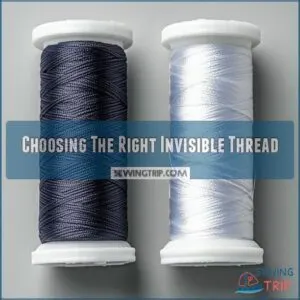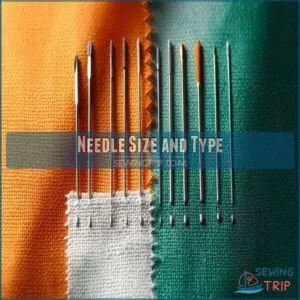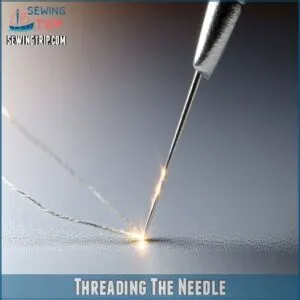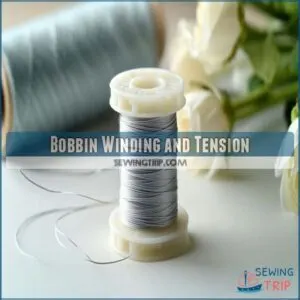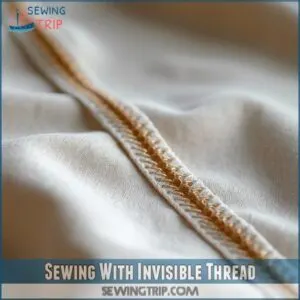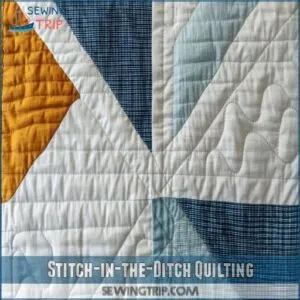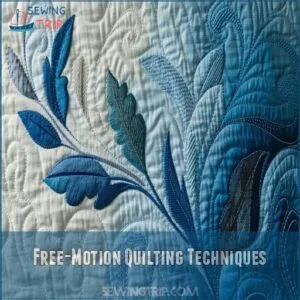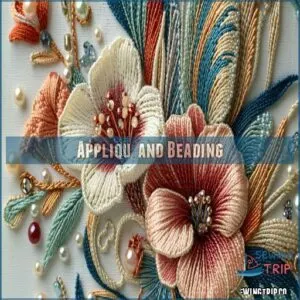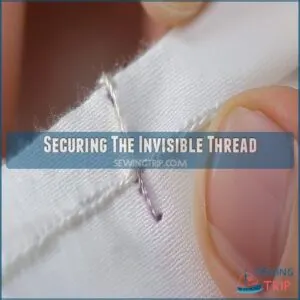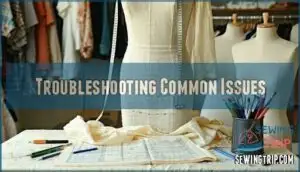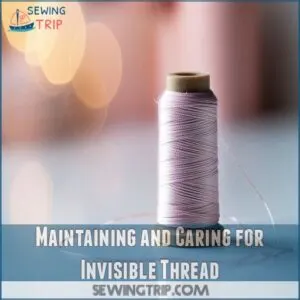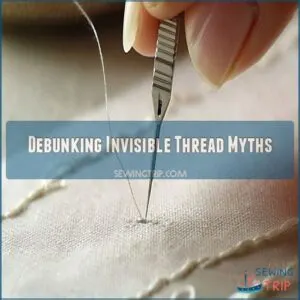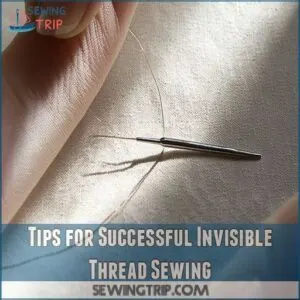This site is supported by our readers. We may earn a commission, at no cost to you, if you purchase through links.
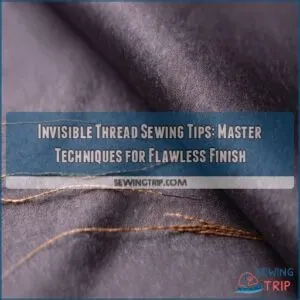 Sewing with invisible thread can feel like taming a mischievous ghost.
Sewing with invisible thread can feel like taming a mischievous ghost.
Choose between nylon and polyester: nylon is flexible but shines, while polyester stays tight and handles heat well.
Match thread color with your fabric—clear for light and smoke for dark. Use a sharp needle, like a size 60/8, to keep stitches smooth and tangle-free.
Wind your bobbin slowly to avoid stretching. Adjust your tension until it’s just right.
Safety pins can act as little helpers by guiding the thread, preventing tangles.
Stay tuned for more secrets to mastering this elusive thread in your sewing projects!
Table Of Contents
- Key Takeaways
- Choosing The Right Invisible Thread
- Threading The Sewing Machine
- Sewing With Invisible Thread
- Invisible Thread Applications
- Securing The Invisible Thread
- Troubleshooting Common Issues
- Maintaining and Caring for Invisible Thread
- Debunking Invisible Thread Myths
- Tips for Successful Invisible Thread Sewing
- Frequently Asked Questions (FAQs)
- Conclusion
Key Takeaways
- Choose between nylon (flexible but shiny) and polyester (heat-resistant and tight) thread types, matching clear thread to light fabrics and smoke to dark ones.
- Use a small needle (size 60/8 or 70/10) and wind your bobbin slowly to halfway full to prevent stretching and tangling.
- Adjust your tension carefully and consider using safety pins as thread guides to maintain smooth stitching.
- You’ll get best results by practicing on scrap fabric first and securing your stitches with backstitching at the seam ends.
Choosing The Right Invisible Thread
Regarding choosing the right invisible thread, you’ve got two main options: nylon and polyester.
Each has its quirks, with nylon being stiffer and polyester more flexible.
making your choice a bit like picking between a rigid fishing line and a pliable shoelace.
Types of Invisible Threads
Invisible thread comes in two main types: nylon and polyester.
It’s essential to choose the right type of invisible thread, considering its properties and applications, to achieve the desired effect in your sewing project.
Nylon thread, sometimes called monofilament, is popular for its invisibility.
Brands like Sulky offer smoke and clear colors to match your fabric.
Choose wisely for a masterful, seamless finish!
Nylon Vs Polyester Invisible Threads
Choosing between nylon and polyester threads can feel like picking between ice cream flavors, each with its charm.
Nylon threads offer more flexibility and dull shine, great for delicate sewing projects.
You can browse a variety of nylon invisible threads online, such as those available at nylon thread products.
Polyester threads are your go-to for heat resistance and stronger knots.
Consider thread durability and cost to find the perfect invisible thread for your masterpiece.
Thread Color Selection
When picking invisible thread, color can make or break your project. Here’s a guide:
- Match the fabric shade: Use clear for light fabrics, smoke for dark ones.
- Consider fabric impact: Test colors on scraps first.
- Experiment with thread types: Every brand behaves differently.
- Best brands: YLI and Sew Art offer reliable options.
These tips will simplify your thread matching!
Threading The Sewing Machine
Threading your sewing machine with invisible thread can feel like trying to find a needle in a haystack.
With the right needle size and type, you’ll be sewing like a pro in no time.
Master the art of bobbin winding and tension adjustments.
Guarantee your invisible thread doesn’t pull any disappearing acts on you mid-seam.
Needle Size and Type
Now that you’ve picked your invisible thread, let’s talk needles.
A smaller needle is your best friend here. Think sizes 60/8 or 70/10; these fine needles glide through the fabric, preventing snags.
You can find suitable sewing needles size 70 options here for purchase.
A sharp needle is a recipe for disaster. Needle material matters less than size and sharpness, but high-quality needles from trusted brands will make the whole process smoother.
The needle gauge impact on your stitches will be significant, so choose wisely.
Threading The Needle
Threading the needle with invisible thread can feel like guiding a phantom line through a ghostly tunnel.
Use a smaller needle size and take your time with this delicate thread type.
Make sure a direct thread path to avoid slips.
If you’re squinting, try wetting the tip—like threading a thin spaghetti strand; it works wonders!
Bobbin Winding and Tension
Getting your invisible thread working smoothly means paying attention to the bobbin. Wind it slowly to about halfway full to keep it from stretching.
Adjust your tension for a seamless stitch.
Remember these key steps:
- Half-full bobbins
- Slow winding
- Tension adjustment
- Preventing stretching
Invisible thread can be tricky, but mastering these tips will save your sewing day!
Sewing With Invisible Thread
Sewing with invisible thread might feel like working with an invisible friend—helpful but occasionally tricky.
You’ll master techniques like using a thread nest and pairing it with a colored bobbin thread for a seamless finish.
That’s sure to impress.
Using a Thread Nest
Don’t let your invisible thread tangle like your last pair of earbuds! For secure thread management, especially at the start and end of your stitches, consider using mini backstitches as described in this helpful guide on anchoring your thread securely.
Embrace the magic of a thread nest—a simple but effective solution to keep your sewing smooth.
| Benefit | DIY Nest Tip | Material Tip |
|---|---|---|
| Reduces Tangling | Wrap threads loosely | Try foam or card |
| Smooth Unwinding | Adjust placement | Use soft materials |
| Enhances Control | Customize size/shape | Match to spool size |
These nests work wonders, giving you the freedom to focus on your design, not a mess of threads.
Combining With Colored Bobbin Thread
Invisible thread’s magic shines when paired with colored bobbin thread, adding depth and intrigue to your projects.
Here’s how to make it work:
- Bobbin Thread Shades: Choose shades that complement or contrast with your invisible thread for striking effects.
- Color Combinations: Play with subtle tones for a seamless look or bold hues for dramatic contrast effects.
- Fabric Matching: Align bobbin thread color with fabric hues for a coherent design.
- Stitch Visibility: Enhance or diminish stitch appearance based on your creative goals.
Invisible Thread Applications
You’ll find invisible thread perfect for projects like stitch-in-the-ditch quilting, where precision is key.
It’s also your secret weapon for free-motion quilting and adding subtle texture to appliqué and beading.
Just avoid losing it in a magic trick like disappearing socks!
Stitch-in-the-Ditch Quilting
Ready to try stitch-in-the-ditch quilting? It’s easier than you think!
Use invisible thread in the needle, and regular thread in the bobbin.
To achieve a professional look, make sure to use a stitch in the ditch foot. Stitch right in the seam allowance.
Practice on a scrap first to get the hang of it.
Different ditch quilting designs let you get creative.
Remember to adjust your ditch quilting tension – you want nice, even stitches, not a messy tangle!
Free-Motion Quilting Techniques
Start free-motion quilting with invisible thread, turning your quilt into a work of art. To achieve professional-looking results, consider investing in the right tools and supplies from Invisible Thread Quilting.
- Design Ideas: Explore unique stitches that add flair.
- Pattern Selection: Choose designs that highlight your quilt’s beauty.
- Stitch Density: Balance to avoid overwhelming patterns.
- Tension Control: Adjust for smooth, even stitches.
- Speed Control: Keep a steady hand.
Appliqué and Beading
Weaving a delicate dance with appliqué and beading adds sparkle to your projects.
Picture thread tension as the guiding hand in your masterpiece, holding fabric choices together effortlessly.
Explore creative appliqué techniques and bead placement to bring life to your designs. Whether stitching invisible thread or crafting imaginative project ideas, it’s like painting with invisible ink—pure magic! appliqué and beading
Securing The Invisible Thread
Securing the invisible thread can feel like catching a ghost, but with a few tricks, you’ll manage just fine.
Using backstitching at seams and safety pins as guides helps prevent tangling.
Turning sewing into a smooth and swift endeavor.
Backstitching at Seams
When sewing with invisible thread, backstitching is your secret weapon for seam security. It keeps your stitches intact and prevents unraveling.
- Backstitch strength: Reinforce ends.
- Seam security: Essential for stability.
- Stitch density: Adjust for fabric type.
- Knot types: Practice basic knots.
- Preventing unraveling: Important for lasting seams.
These invisible thread tips guarantee a flawless finish!
Using Safety Pins as Thread Guides
Using safety pins as thread guides helps direct your invisible thread along a tension-free path.
Choose smaller pin sizes to minimize fabric impact. Make certain the pin material won’t snag threads—stainless steel works well.
Place pins strategically to guide without resistance.
Just don’t forget to remove them!
These invisible thread tips make sewing seem like a breeze.
| Pin Feature | Details |
|---|---|
| Placement | Strategic for smooth path |
| Size Impact | Smaller pins, less intrusion |
| Material | Stainless steel preferred |
| Effect on Thread | Guides thread tension-free |
| Removal | Essential after sewing |
Preventing Thread Tangling
Invisible thread tangling can drive anyone batty!
To keep things smooth, check your thread path often.
Watch that bobbin tension—it’s like Goldilocks, not too tight or loose.
Choose the right needle type, and use thread guides for better spool management.
Consider this your sewing machine’s zen moment, where perfect thread tension leads to frustration-free stitching. Perfect thread tension is key.
Troubleshooting Common Issues
Let’s face it, even the most experienced sewists encounter snags—sometimes literally!
This section will help you troubleshoot common invisible thread problems,
getting you back to creating beautiful projects in no time.
Thread Tangling and Breakage
To avoid thread tangling and breakage, think of your sewing machine as a puzzle. If the pieces don’t fit, chaos ensues.
Here’s how to keep it smooth:
- Thread tension: Adjust until it feels just right.
- Needle choice: Match it to your fabric.
- Prevent tangles: Check your thread path, ensuring it’s snag-free.
Addressing Bobbin Case Burrs
If your stitches are hitting a snag, burrs in the bobbin case might be the culprit. These tiny metal rough spots disrupt the smooth bobbin winding, causing thread tangles. Grab a burr removal tool and smooth things out. Like filing down a sharp edge, it keeps your sewing machine in top shape for flawless invisible thread sewing.
| Step | Tools Needed |
|---|---|
| Identify Burrs | Magnifying Glass |
| Gather Tools | Burr Removal Tools |
| Remove Burrs | Fine Metal File |
| Test Bobbin | Sample Fabric |
| Maintain Smooth | Regular Checkups |
Modifying The Thread Path
Are your thread path tweaks giving you headaches?
When your invisible thread starts tangling, optimizing tension and needle placement can work wonders.
Make a smooth flow by guiding your thread correctly through the sewing machine’s intricate route.
It’s like untangling a necklace—a little patience and finesse, and your machine sewing will glide effortlessly again, showcasing brilliant invisible thread techniques.
Maintaining and Caring for Invisible Thread
Caring for your invisible thread is all about keeping it cool and tidy, so you can avoid any tangled mess or unexpected shrinkage.
It’s best to press projects with a cloth and on low heat.
Wash delicately.
Consider using an external thread stand for smooth sewing. Avoid tangled mess and shrinkage.
Ironing and Pressing Projects
When ironing your sewing projects, don’t let the heat take you by surprise!
Invisible thread prefers a gentle touch.
To prevent ironing board marks on clothes, use techniques such as adding extra padding under the ironing board cover.
Use low heat settings and a pressing cloth to protect the thread from melting.
Steam options can help, but too much moisture might mess with your fabric.
Keep the iron moving to avoid any unwanted glossy spots.
Happy sewing!
Washing and Drying Instructions
Keeping your sewing projects fresh? Choose a gentle wash cycle and cool dryer settings to prevent invisible thread mishaps.
Different fabric types need some love—consider a pre-wash treatment for the finicky ones.
For post-wash care, treat projects like royalty: no high heat, please! Your invisible thread will thank you with long-lasting durability.
- Gentle wash cycle
- Cool dryer settings
- Pre-wash treatment
Using an External Thread Stand
After washing and drying, consider a thread stand—it’s a game-changer!
These handy tools keep your invisible thread tangle-free.
Many types exist, from simple tabletop stands to more elaborate models. Choose one that fits your spool size and workspace.
Proper stand placement prevents snags and keeps your sewing flowing smoothly. You’ll wonder how you ever sewed without one!
Debunking Invisible Thread Myths
You might’ve heard tales of invisible thread wrecking sewing machines or ruining quilts, but don’t worry—those myths are as flimsy as a ghost’s cloak.
High-quality modern threads are safe and reliable,
so rest assured your projects remain beautiful without hidden hazards.
Sewing Machine Damage Concerns
Worried about invisible thread causing machine damage? Put those fears to rest.
Modern invisible threads are machine-friendly, so focus on keeping your sewing setup in good shape.
With proper thread care and sewing machine maintenance, you can avoid needle breakage and bobbin issues.
Just adjust tension to prevent thread jams. It’s like giving your machine a regular spa day!
Quilt Ruin and Color Change
You might fret about quilts suffering from color changes or damage with invisible thread, but worry not—your creations are safe. Invisible thread like polyester and nylon is sturdy, ensuring quilts remain vibrant.
- Colorfastness tests: Protect your quilt’s fabric.
- Preventing dye bleed: Check fabrics beforehand.
- Thread care: Extend your thread’s lifespan and avoid mishaps.
Child Safety and Invisible Thread
Regarding child safety, invisible thread isn’t a villain in disguise.
While nylon and polyester threads may look tempting to curious little hands, they’re not more dangerous than other sewing supplies.
To avoid any hiccups, keep your thread stash out of reach. Supervision is your ally against the rare swallowing risk or choking hazard, ensuring a safe sewing environment.
Tips for Successful Invisible Thread Sewing
When you’re starting with invisible thread, choose a trusty test piece to avoid surprises and giggles from accidental thread tangles.
Mixing and matching bobbin thread colors can keep your creativity buzzing, just like trying on socks with mismatched patterns.
Practicing With a Test Piece
Testing with a scrap piece isn’t just for fun; it’s your backstage pass to sewing success. Here’s how:
- Scraps Usage: Repurpose those fabric scraps to practice with invisible thread.
- Stitch Density: Play around with stitch density to find perfection.
- Tension Adjustments: Make small tension tweaks for flawless stitches.
Evaluate results for smoother primary projects.
Choosing The Right Bobbin Thread
So, you’ve mastered the test piece – high five!
Now, let’s talk bobbin thread. The right bobbin thread is key for a seamless invisible thread experience. Consider a 50wt cotton, poly, or specialty thread. Proper bobbin thread weight and type guarantee thread compatibility.
Don’t forget about bobbin tension – it’s a game-changer!
Matching bobbin thread to your top invisible thread (nylon or polyester) makes all the difference. A little experimentation will lead you to the perfect match!
Experimenting With Different Thread Shades
You’ve already tackled choosing the right bobbin thread.
Now let’s shake things up by experimenting with different thread shades. Shade matching can transform your sewing projects by creating stunning color blends.
Test smoky-colored threads on dark fabrics, and watch how light effects play out.
Always do a fabric test to troubleshoot shades before diving into your masterpiece.
Frequently Asked Questions (FAQs)
How do you sew with invisible thread?
Studies show 90% of sewing issues stem from improper thread use.
Choose nylon or polyester invisible thread.
Use a small needle (60/8 or 70/10).
Wind bobbin halfway, reduce top tension, and practice on scrap fabric first.
What needle should I use with invisible thread?
Choose a smaller needle size like 60/8 or 70/10 for invisible thread sewing.
You’ll need to thread these needles manually.
They’ll create less visible holes and help maintain the thread’s invisible effect.
How to secure an invisible thread?
Backstitch at both ends when starting and finishing your seams.
For extra security, reduce stitch length to 5mm for the first and last few stitches.
You’ll also want to leave longer thread tails.
What bobbin thread to use with invisible thread?
You’ll want to use a standard 50-weight cotton or polyester thread in your bobbin when working with invisible thread on top.
This combo gives you the perfect balance of stability and clean stitching.
How to store invisible thread effectively?
Store your thread in a cool, dry place away from direct sunlight.
Keep it in its original packaging or wrap it around a thread holder.
Using thread nets prevents tangling.
Don’t forget to label storage containers.
Can invisible thread be dyed or colored?
Standard invisible thread can’t be dyed, as it’s chemically treated for transparency.
If you need colored transparent thread, look for pre-tinted options like "smoke" or consider using ultra-fine colored polyester threads instead.
Whats the lifespan of invisible thread?
Like a well-oiled machine, your invisible thread can last 3-5 years when stored properly.
With good care – keeping it away from direct sunlight and extreme temperatures – you’ll maximize its useful lifespan.
Is invisible thread suitable for stretchy fabrics?
You’ll want to avoid invisible thread on stretchy fabrics since it doesn’t have enough give.
The rigid nature of both nylon and polyester versions can restrict fabric movement and potentially cause seams to break.
How to prevent static buildup with invisible thread?
Running your thread through a dryer sheet reduces static cling.
You can also try rubbing thread with beeswax.
Using fabric softener sheets near your workspace is another option.
Keeping a humidifier nearby to control static is also helpful.
Conclusion
While invisible thread sewing tips might seem challenging at first, you’ll find it’s worth mastering these techniques for that professional, polished finish.
Start with small projects, adjusting tension and practicing on scraps until you’re comfortable.
Remember to match your thread type to your project needs – nylon for flexibility, polyester for heat resistance.
With patience and these proven invisible thread sewing tips, you’ll soon be creating stunning, seamless projects that look like they were crafted by a pro.

